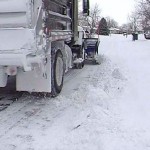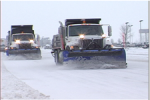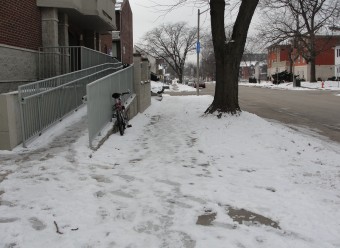SNOW REMOVAL
Street Snow Removal
The Public Works Department is responsible for providing snow and ice control for the City’s streets and parking lots. To help provide this service, the City has developed a Snow and Ice Control Plan.
The Public Works Department’s goal is to provide the best service possible to our citizens during and after a snow and ice event. There are several things that you can do to help the City achieve this goal. Primary routes, which make up approximately 50 percent of the total street system, include arterial streets, collector streets, bus routes, and school and hospital routes. Primary routes have been established so most residents are within three blocks of a primary route. Primary routes are divided into seven separate routes with routes varying between 19 and 25 miles in length. For more information, go to the “Primary Snow Routes Map.” The remaining City streets, dead-end streets, and cul-de-sacs are classified as secondary routes. Snow and ice activities take place on these streets only after the primary routes have been completed. Activities on secondary routes are sometimes interrupted to return to the primary routes during snow events. There are streets within the City of Champaign that are owned and maintained by the Illinois Department of Transportation (IDOT). Snow and Ice control on those streets are the responsibility of IDOT. IDOT streets within the City of Champaign are depicted on the “Primary Snow Routes Map” and listed below: For storm events with an accumulation of four inches and more, City alleys will be cleared. Alley snow removal will be done during regular work shifts and completed after all City streets, sidewalks, and parking lots have been cleared. The City uses three types of chemical deicers for its snow and ice response: rock salt (sodium chloride), liquid calcium chloride (a 32-percent solution of calcium chloride), and salt brine. All deicers work by lowering the freezing point of water. Factors affecting the deicing capability of chemicals include the concentration of the chemical relative to water, temperatures (especially pavement temperatures), time, weather, road type, topography (specifically when material or man-made objects shade the road surface), and traffic patterns. Rock salt is an effective deicing chemical until temperatures drop to about 20 degrees. Rates for salt application vary. At a temperature range of 25 to 30 degrees, application rates of 100 to 200 pounds per lane mile can provide adequate control. At temperatures of 20 degrees, a rate of 300-400 pounds of salt might be required for adequate control. Liquid calcium will melt snow and ice at lower temperatures than rock salt. Typically, liquid calcium is mixed with rock salt at a ratio of 6 to 12 gallons of liquid to 1 ton of salt, although rates up to 15 gallons can be used. Used in combination with salt, the mixture gives a quicker response than salt alone, will work at temperatures as low as five degrees, and reduce “bounce.” Wetting the salt material with liquid calcium chloride reduces salt “bounce” and keeps more of the salt on the drive area of the pavement. Salt brine, a 23-percent solution of salt water, will also provide benefits as a pre-wetting agent. This liquid solution is used at higher temperatures than liquid calcium. Salt brine will be used when temperatures are expected to be above 25 degrees during the event. Salt brine can be mixed at rates of 6 to 12 gallons per ton of salt. Anti-icing is a treatment strategy that aims to prevent ice from bonding to pavement surfaces. It involves applying ice control chemicals before, or at the onset, of a snow and ice event. Liquid materials can be applied at rates of 25 to 50 gallons per lane mile up to 72 hours in advance of a storm. The liquid material dries, leaving behind an anti-icing coating that will prevent moisture from bonding to the pavement. Depending on expected precipitation and temperatures, either brine or liquid calcium is used. Streets within the City are prioritized to clear major travel routes first. This allows public safety vehicles access to most parts of the City. The initial plowing activities also provide most residents a cleared roadway within two-to-three blocks of their home and most destinations in the City. Other factors include locations of schools, hospitals, major commercial centers, and other facilities with large public interest. The City has thousands of driveways along City streets. Clearing drive openings would require a large commitment of resources in labor and equipment at a time when those resources are dedicated to clearing primary snow route roadways and neighborhood streets. It is the City’s goal to plow all primary snow route streets within 12 hours after the snowfall has stopped. Neighborhood streets will be plowed within 24 hours after primary routes have been completed. Cul-de-sacs and dead-end streets will be plowed within 36 hours after primary routes have been completed. It’s not possible to provide an exact time for clearing each individual street or address. Weather conditions such as blowing or drifting snow or other weather events make exact predictions difficult. See the “Primary Snow Routes Map” for more information. Several factors influence decisions made to reduce winter weather hazards. Current air temperatures, predicted air temperatures, time of day, and precipitation type are all important considerations when determining an appropriate response. In some cases, plowing alone will be most effective at addressing the hazards. In some events, such as cold pavement with dry and blowing snow, application of salt or other chemicals could create a problem by allowing moisture to accumulate and possibly freeze on the otherwise dry pavement. Depending on conditions, the trucks may be applying anti-icing materials, checking road conditions, or returning to the Public Works Center for additional materials. Abrasives like sand and cinders are used in some areas to increase traction. Use of abrasives, however, would create additional problems with storm water sedimentation and degradation and obstruct storm water sewers. Abrasives also can cause problems if carried indoors on shoes and boots. Abrasives do not melt snow and ice and are not as effective at providing safer winter roadways. The Public Works Department works with METCAD and the Champaign Police and Fire Departments to make sure that these public safety agencies can provide emergency services during winter weather events. Anyone experiencing a medical emergency should call 911. The METCAD dispatchers will make sure a plow is available to clear the way for Fire and ambulance crews. The City encourages residents to use off-street parking whenever possible during snowfall, as it allows for more snow clearing and less piling up of snow on the sides of the streets. In the rare instance of an abandoned vehicle which is preventing snowplows from getting to a certain street, the Champaign Police Department will be able to tell persons whose cars have been towed where they were relocated. The phone number for the Police Department’s front desk is 217-351-4545. The State of Illinois Department of Transportation is responsible for maintenance of State roadways, including snow removal. State roads are identified on the “Primary Snow Routes Map.” The prioritization for snow clearing is set to provide safe travel for as many people as possible as quickly as possible. By starting with major routes and then through residential streets, the biggest impact is possible. Cul-de-sacs and dead-end streets usually have lower traffic volumes, and are therefore cleared after higher traveled roadways. Also, because of their configuration, cul-de-sacs and dead-ends cannot be plowed using the more conventional truck-plowing units used on other City streets. Since there are fewer of these units than the large truck plows, short delays in plowing these special areas sometimes occur. Questions regarding snow and ice removal can be directed to the Public Works Operations Division at 217-403-4700. Report any damage as soon as possible to the Public Works Department Operations Division at 217-403-4700. Please be prepared to provide the following information: Your name, address, phone number, and a description of the damage. Note: Most people think it is the snowplow that actually hits the mailbox. Although this happens occasionally, the snow that is thrown by the plow is usually the cause of mailbox damage. The wetter and heavier the snow, the greater the potential for damage to mailboxes when snowplowing occurs. Residents can help to avoid this by making sure the mailbox poles or supports are in good condition.Snow and Ice Control Plan Details
Resources
 Public Works’ normal work shift is 7 a.m. to 3 p.m., Monday through Friday. If the snow and ice event is expected to arrive or continue past the normal end of the day, Public Works staff is split into A and B shifts. Each A and B shift generally works 12 hours, providing a 24-hour response capability with 14 snow plow trucks.
Public Works’ normal work shift is 7 a.m. to 3 p.m., Monday through Friday. If the snow and ice event is expected to arrive or continue past the normal end of the day, Public Works staff is split into A and B shifts. Each A and B shift generally works 12 hours, providing a 24-hour response capability with 14 snow plow trucks.Helpful Hints
Primary and Secondary Snow Routes
 The City’s Snow and Ice Control Plan divides City streets into primary and secondary routes.
The City’s Snow and Ice Control Plan divides City streets into primary and secondary routes.
Alleys

Deicers
Anti-icing
Why can’t you plow my street now?
The plow left some snow at the end of my driveway. Can you send someone to come and plow it out?
Can you tell me exactly when my street will be plowed?
Why do you sometimes salt instead of plow or plow instead of salt?
Why do snow plow trucks sometimes just ride around when it’s not snowing?
Salt corrodes my car, sidewalk, and drive. Couldn’t you use cinders instead?
I have a heart condition. Can you plow my street in case there is an emergency and an ambulance needs to get through?
When is parking prohibited on City streets?
Where are cars taken when they are towed for being parked on the street prohibiting snowplows from completing operations?
Who is responsible for plowing the State roads?
Why does it take longer to plow cul-de-sacs and dead-end streets?
Who do I contact if I have questions?
Who do I contact if the City’s snow removal activities have damaged my property, car, or mailbox?
Sidewalk Snow Removal
 As of November 1, 2007, owners of property located within the University District and the Downtown area are responsible for removing snow, ice, sleet, or freezing rain from the sidewalk adjacent to their property.
As of November 1, 2007, owners of property located within the University District and the Downtown area are responsible for removing snow, ice, sleet, or freezing rain from the sidewalk adjacent to their property.
The goal of the ordinance is to maintain accessibility for the general public who rely on our sidewalk system to carry out their daily activities. The ordinance applies when accumulations are of 2 inches or greater. The City’s Public Works Director will publicly declare when the ordinance requirements are officially in effect. Owners then have 48 hours to comply with the declaration. A path the width of the sidewalk or 48 inches, whichever is less, is required to be maintained.
Property owners on corner lots are also required to shovel paths to the nearest crosswalk. Snow should be stored on your property, if possible, or in the parkway between the sidewalk and the street curb. Please bear in mind that streets with on-street parking still need access to vehicles and parking meters. Snow cannot be deposited onto City Streets. The preceding information is provided as examples of nuisance violations but it is not intended to be an all-inclusive list of every violation. For further information please review the City code or consult with an inspector.
For more information, please contact:
City of Champaign
Public Works Department
702 Edgebrook Drive
Champaign, IL 61820
217-403-4700
[email protected]